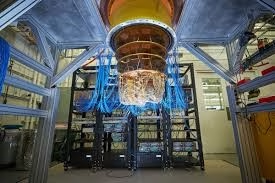The race to build the world’s first truly industrial-scale quantum computer is accelerating. While small-scale quantum processors with tens or even hundreds of qubits exist today, the leap to practical machines capable of solving commercially valuable problems requires systems with over one million reliable qubits. By the end of this decade, two companies—Google and IBM—stand at the forefront of this technological competition, deploying fundamentally different strategies in qubit design, error correction, and modular scaling.
The Million-Qubit Target
The current quantum landscape is dominated by noisy intermediate-scale quantum (NISQ) devices, which typically house a few hundred qubits. These machines are powerful for experimentation and limited problem-solving, but noise, decoherence, and gate errors limit their utility. To break beyond this regime, large-scale fault-tolerant quantum computers must integrate millions of logical qubits—error-corrected entities constructed from many more fragile physical qubits.
- Estimates suggest that creating a single logical qubit may require anywhere from 1,000 to 10,000 physical qubits, depending on error rates and error correction codes.
- Thus, scaling to the million-qubit level demands not just more qubits but more efficient architectures, robust error correction, and scalable control systems.
This is where Google and IBM diverge in vision and execution.
Google’s “Moonshot” Path: Surface Codes and Breakthrough Error Correction
Google’s 2019 demonstration of “quantum supremacy” with its 53-qubit Sycamore processor was largely symbolic but underscored its ambition. Since then, Google has pivoted toward the enormous challenge of error correction.
- Surface Code Strategy: Google has committed to the surface code, widely regarded as the most promising scheme for error correction. In 2023, it announced it had successfully reduced logical error rates by increasing code distance, proving that scaling codes can indeed lower error probability.
- Milestone Goal: By 2029, Google aims to build a 1 million physical qubit system, capable of supporting thousands of logical qubits. The long-term target is to perform chemistry simulations, materials design, and cryptography-shattering tasks impossible for classical supercomputers.
- Hardware Approach: Google’s hardware remains based on superconducting qubits, which are lithographically fabricated and controlled using microwave pulses. The challenge lies in wiring, cooling, and synchronizing millions of qubits in a dilution refrigerator—pushing current cryogenic and control engineering to the limits.
Google’s approach is essentially a single-platform moonshot, betting that rapid advances in surface-code scaling will yield a robust, monolithic system.
IBM’s Modular Scaling Strategy: Building a Quantum “Supercomputer”
IBM, by contrast, has pursued a modular roadmap—developing increasingly large superconducting processors while planning to connect them into networked clusters.
- Processor Scaling: IBM unveiled its 433-qubit Osprey processor in 2022 and a 1,121-qubit Condor chip in 2023. These are the largest quantum processors built to date, though they remain NISQ-class devices.
- Error Mitigation + Correction: IBM emphasizes near-term error mitigation techniques—improving results from noisy systems through classical post-processing—while gradually layering in error correction. This pragmatic approach allows IBM to deliver useful quantum services sooner, even before full error-corrected systems are ready.
- Modularity: IBM envisions future machines as clusters of quantum chips, linked via quantum communication channels. Instead of packing one million qubits into a single cryostat, IBM seeks to create a distributed architecture, analogous to classical supercomputing.
- Roadmap: By 2033, IBM expects to deliver large-scale systems with 100,000+ qubits, moving toward modular networks that could eventually surpass the million-qubit threshold.
IBM’s strategy is less about a single breakthrough and more about progressive scaling, hybridization with classical computing, and client-facing utility.
Diverging Philosophies: Moonshot vs. Pragmatism
The divergence between Google and IBM reflects two competing philosophies of deep-tech development:
- Google: Prioritizes long-term disruption. Its focus is on error-corrected, fully fault-tolerant machines, even if commercial applications remain distant. The payoff, if achieved, could be transformative and monopolistic.
- IBM: Pursues steady incrementalism, balancing innovation with business deployment. Its cloud-based IBM Quantum Network already allows clients to experiment with real devices, positioning IBM as a service provider in the NISQ era while preparing for the fault-tolerant future.
Why the Stakes Are Enormous
A practical million-qubit quantum computer could unlock capabilities such as:
- Drug and material discovery: Simulating molecular interactions at atomic precision.
- Climate modeling: Optimizing energy systems, materials for carbon capture, and fusion reactions.
- Cryptography: Breaking RSA and other widely used public-key systems.
- Optimization: Solving intractable logistics and financial modeling problems.
The company that achieves industrial-scale quantum advantage first may enjoy an advantage as profound as the advent of classical computing in the mid-20th century.
The Road Ahead
Both Google and IBM face daunting technical challenges: maintaining coherence times, suppressing crosstalk, scaling cryogenic systems, and inventing new control electronics. But their distinct strategies—Google’s moonshot in error correction versus IBM’s modular pragmatism—illustrate the diverse pathways to quantum industrialization.
If history is any guide, the race may not crown a single winner. As in classical computing, multiple architectures and ecosystems may coexist. What is certain is that the 2020s will be remembered as the decade when quantum computing shifted from laboratory curiosity to industrial reality.






